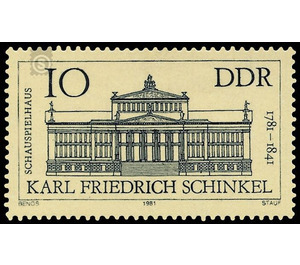200th birthday of Karl Friedrich Schinkel - Germany / German Democratic Republic 1981 - 10 Pfennig
Theme: Art & Culture
| Country | Germany / German Democratic Republic |
| Issue Date | 1981 |
| Face Value | 10.00 |
| Color | brown |
| Perforation | K 14 |
| Printing Type | combined engraving and squeegee printing |
| Stamp Type | Postage stamp |
| Item Type | Stamp |
| Chronological Issue Number | 2361 |
| Chronological Chapter | GER-DDR |
| SID | 775948 |
| In 14 Wishlists | |
200th birthday of K. F. Schinkel On the occasion of the 200th birthday of Karl Friedrich Schinkel, the Ministry of Postal and Telecommunications of the German Democratic Republic issues two special postage stamps, which were designed according to Schinkel's original drawings. Special cancellation from June 23 to August 22, 1981 Karl Friedrich Schinkel The publication of the special postage stamps on the occasion of the 200th birthday of Karl Friedrich Schinkel (March 13, 1781 - October 9, 1841) became one of the most important and influential architects in Germany of the 19th century honored. Karl Friedrich Schinkel was born on March 13, 1781, the son of a pastor in Neuruppin. After the early death of his father, relocation of the mother with the children to Berlin. There Schinkel attended high school to the Gray Monastery, discovered very early his passion for drawing and architecture. Left the school early to devote himself exclusively to these inclinations. He became a pupil of David Gilly and his son Friedrich, who at the time belonged to the most renowned German architects. Friedrich Gilly's works in particular, influenced by French revolutionary architecture, had a lasting effect on the young Schinkel. In addition, Schinkel completed some courses at the Bauakademie and completed his training as a construction engineer. From 1803 to 1805 he made an educational trip to Italy. He brought with him mainly landscape paintings, sketches and drawings, which caused considerable sensation in the art circles in Berlin, and established their reputation as outstanding draftsman and painter through their high ability and their new artistic concept. Until 1810 he was forced by Napoleon to earn his living as a painter and draftsman due to the general bad economic situation during the occupation of Prussia. He became known to the Berliners by oversized graphs, which were shown in the diorama theater of the brothers Gropius. In 1810 Schinkel was appointed by the Minister of Hardenberg and Wilhelm von Humboldt the appointment as assessor for the aesthetic subject in the Oberbaudeputation, the Prussian supreme construction supervision authority. Schinkel stays in this office until his death. In 1815 he became a senior civil engineer, in 1830 chief building director and in 1838 senior land building director. In addition, in 1819 he became a member of the Technical Deputation in the Ministry of Trade, Commerce and Construction, 1820 Member of the Senate of the Academy of Arts in Berlin. He becomes a corresponding member of numerous foreign academies, ia. Appointed by the Associé étranger, the Royal Academy of Fine Arts in Paris and the Academy of Fine Arts in St. Petersburg. His fame and importance were mainly explained by his numerous designs and buildings, which he carried out outside his actual work in the building supervisory authority. His most important buildings are in Berlin and Potsdam: The Neue Wache (today memorial) (1816-1818), the Schauspielhaus (1818-1821), Schloßbrücke (Marx-Engels-Brücke), Altes Museum (1824-1830), Werdersche Kirche ( 1824-1830), Bauakademie (1831-1836), Schloß Charlottenhof and the Roman Baths in Potsdam-Sanssouci (1826-1833), Nikolaikirche in Potsdam (1830-1837), Schloss Babelsberg (1833). Outside these two cities belong to his main works: the Nikolaikirche and the society house in Magdeburg, the Hauptwache in Dresden, the Johanniskirche and the city hall in Zittau as well as village and castle Neuhardenberg (Marxwalde). In addition there is the restoration of numerous historical buildings as well as designs for monuments: Tomb of Scharnhorst on the Invalidenfriedhof in Berlin, Klopstock monument with Stolberg, canopy of the Luther monument in Wittenberg, tomb of Gustav Adolfs in Lützen, monument for the queen Luise in the market place of Gransee. On October 9, 1841 Schinkel dies after a severe illness lasting a year. He was buried at the Dorotheenstadt cemetery in Berlin. The special postal stamps contain the reproduction of the facades of the Altes Museum and the Schauspielhaus, made from engravings by Schinkel, published in the publication "Collection of Architectural Designs" published by him.


